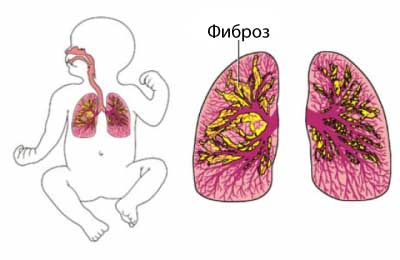Bronholegochnaya dysplasia
Description of bronchopulmonary dysplasia
Bronholegochnaya dysplasia (BPD) – abnormal lung development in children. It is considered to be chronic lung disease. BPD may hinder breathing. Disorder usually develops within the first four weeks after birth.
BPD occurs more often in children, who were born prematurely with immature lungs. Most babies with BPD recover. But, It is a serious disease, which needs care physician.

Reasons for bronchopulmonary dysplasia
The exact cause of BPD is unknown. Her appearance is most often associated with complications in the early stages of lung disease or treatment. These disorders and procedures may cause irritation and swelling of the lungs and airways, which can lead to BPD.
Risk factors for bronchopulmonary dysplasia
Factors, which increases the risk of bronchopulmonary dysplasia:
- Any serious diseases, requiring oxygen therapy and / or use of the ventilator for a long time;
- Respiratory Distress Syndrome (RDS) – disorder often affects preterm infants, which causes difficulty in breathing;
- Collapsed lung;
- Miscarriage;
- Immature lungs;
- High blood pressure;
- Congenital heart defects, causing excess blood flow through the lungs (eg, patent ductus arteriosus);
- Traheomalyatsiya;
- Podsvyazochnыy stenosis;
- Infection;
- Pneumonia.
Symptoms of bronchopulmonary dysplasia
The following are the most common symptoms in BPD. But, they can also be caused by health. If your child has any of the symptoms, consult a doctor.
- Fast, shallow breathing;
- Labored breathing;
- Retrakciâ;
- Cough;
- Movement of the chest and abdomen in opposite directions when the breaths;
- Shortness of breath or noisy breathing;
- Sputum or noise in the lungs, which can be heard, using a stethoscope;
- Raising the head or neck stretching, to breathe in more air into the lungs;
- Poor posture of the trunk, shoulders and neck;
- Bluish skin color;
- The slow growth rate.
Diagnosis of bronchopulmonary dysplasia
The doctor will examine the child's medical history and a physical exam. They can be assigned to the following tests:
- Analysis of arterial blood gas – a small amount of blood is taken, to determine the amount of oxygen;
- Chest X-ray – used X-rays, to take a picture of the inside of the chest;
- Chest CT – type of X-ray, that uses a computer to produce images of structures inside the chest;
- Pulse oximetry – tape, containing oxygen sensor, installed on the leg of the child. With this method it is possible to determine, how well your lungs work.
Treatment of bronchopulmonary dysplasia
Special treatment for BPD does not exist. The main attention should be paid to the treatment of symptoms. If necessary, treatment may include support for the child's breathing. This will help to light fully mature.
The child is likely, It will be sent to the hospital for quite a long period of time. Treatment options include the following:
Ventilation
For delivery of air into the lungs using a ventilator. It can support your child, while the lungs are not mature.
Supplemental oxygen
Oxygen can be transported through a mask or tube in the nose. Treatment can last for weeks or even months. Sometimes the child may still need oxygen after coming home from the hospital.
Medicines
Doctor prescribes a medication, based on the needs of the child. The formulations may comprise:
- Surfactant (surfactants) – They can be given soon after birth, to help the baby's lungs to expand;
- Antibiotics – infection control;
- Bronhorasshiriteli – dilates the bronchi child, increasing the amount of air, entering the lungs;
- Corticosteroids – to reduce the swelling and inflammation of airways;
- Diuretics – to help remove excess fluid from the lungs.
Feeding
Lung problems may hinder feeding. Special feeding the baby will become more strong and healthy. Methods of feeding a child with BPD may include:
- Venous Catheter, which is injected directly into a vein;
- Tube Supply, which is inserted into the stomach;
- Special infant formula for, to feed the baby from a bottle.
Early intervention therapy
Early intervention therapy can include several types of treatment. They will help improve the development of the baby. Treatment may include special exercises, to strengthen the muscles and bring the mucus from the lungs.
If an infant diagnosed with BPD, Follow your doctor's instructions.
Prevention of bronchopulmonary dysplasia
There are no guidelines for preventing BPD. Nonetheless, there are some things, which can be, to reduce the risk of preterm delivery and having a healthy baby:
- Eat a healthy diet. Choose foods low in saturated fats and dairy products low in fat. Choose lean protein sources. Include in the diet of food from whole grains, fruits and vegetables;
- Perform regular prenatal examination;
- Do not smoke. If you smoke, to throw;
- Avoid alcohol and drugs.
